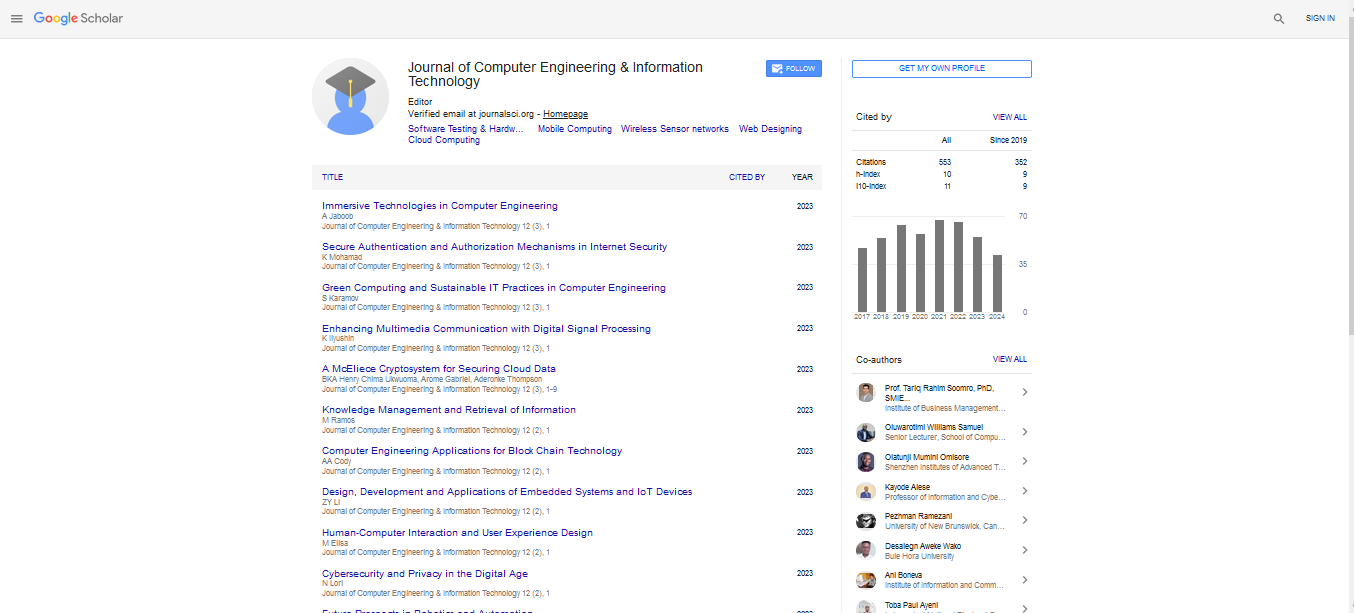Editorial, Jceit Vol: 14 Issue: 1
Digital Logic Design: The Foundation of Digital Systems
Xin Guong*
College of Information Engineering, Hunan Mechanical & Electrical Polytechnic, Hunan, China
- *Corresponding Author:
- Xin Guong
College of Information Engineering, Hunan Mechanical & Electrical Polytechnic, Hunan, China
E-mail: guong@xin.cn
Received: 01-Jan-2025, Manuscript No. jceit-25-169308; Editor assigned: 4-Jan-2025, Pre-QC No. jceit-25-169308 (PQ); Reviewed: 20-Jan-2025, QC No jceit-25-169308; Revised: 27-Jan-2025, Manuscript No. jceit-25-169308 (R); Published: 31-Jan-2025, DOI: 10.4172/2324-9307.1000331
Citation: Xin G (2025) Digital Logic Design: The Foundation of Digital Systems. J Comput Eng Inf Technol 14: 331
Introduction
Digital Logic Design is the cornerstone of modern digital electronics and computing systems. It deals with the representation, manipulation, and implementation of binary information through logical operations. Digital logic circuits form the fundamental building blocks of computers [1], communication devices, and virtually all digital systems. Understanding digital logic design is essential for engineers and computer scientists as it bridges the gap between hardware and software, enabling the creation of efficient, reliable, and scalable digital devices.
What is Digital Logic Design?
Digital Logic Design involves the study and application of logic gates and circuits to perform logical operations on binary variables [2]. At its core, it translates Boolean algebra into physical hardware components that can process binary data, represented as 0s and 1s. These logic gates (AND, OR, NOT, NAND, NOR, XOR, XNOR) combine in various configurations to form complex circuits like multiplexers, decoders, flip-flops, and arithmetic units.
Key concepts in digital logic design include:
Boolean Algebra: A mathematical framework for analyzing and simplifying logic circuits [3].
Combinational Logic Circuits: Output depends solely on the current inputs (e.g., adders, multiplexers).
Sequential Logic Circuits: Output depends on current inputs and previous states, involving memory elements (e.g., flip-flops, counters).
Minimization Techniques: Methods like Karnaugh Maps and Quine-McCluskey [4] to simplify logic expressions.
Components of Digital Logic Design
Digital logic design encompasses several components:
Logic Gates: Basic building blocks that perform fundamental logical operations.
Combinational Circuits: Circuits with outputs based on present inputs, no memory (e.g., arithmetic logic units).
Sequential Circuits: Circuits that incorporate memory elements and feedback, essential for storage and state machines.
Registers and Counters: Sequential circuits used for data storage and counting operations.
Programmable Logic Devices: Devices like PLDs, FPGAs, which can be programmed to implement complex digital functions.
Applications of Digital Logic Design
Digital logic design is at the heart of many electronic systems and technologies:
Microprocessors and Microcontrollers: Central processing units rely on digital logic circuits for instruction execution.
Memory Devices: RAM, ROM, and caches utilize sequential logic for storing information.
Communication Systems: Encoding, decoding, and error detection rely on combinational and sequential logic.
Consumer Electronics: Digital clocks, calculators, and embedded systems.
Automated Control Systems: Robotics, industrial machines, and traffic control use logic circuits to operate reliably.
Challenges and Future Directions
With the ongoing demand for faster and more efficient digital systems, challenges include managing power consumption [5], minimizing circuit complexity, and enhancing speed. Advances in technology like nanotechnology and quantum computing promise to revolutionize digital logic design.
Emerging trends include:
Low-Power Design Techniques: Essential for portable and IoT devices.
Design Automation: Use of CAD tools to optimize and simulate circuits.
Reconfigurable Computing: Utilizing FPGAs for flexible hardware solutions.
Integration with AI: Logic circuits optimized for neural networks and machine learning.
Conclusion
Digital Logic Design remains a fundamental discipline that underpins the entire field of digital electronics and computing. By translating abstract logic into tangible hardware, it enables the design of complex systems that power modern technology. Continued innovation in digital logic design will be pivotal in meeting the evolving demands of computing performance, energy efficiency, and device miniaturization.
References
- Mano MM., Ciletti MD (2017) Digital Design. Pearson.
- Roth CH, Kinney LL (2014) Fundamentals of Logic Design. Cengage Learning.
- Floyd TL (2019) Digital Fundamentals. Pearson.
- Wakerly JF (2017) Digital Design: Principles and Practices.
- Harris D, Harris S (2012) Digital Design and Computer Architecture. Morgan Kaufmann.
Indexed at, Google Scholar, Crossref
Indexed at, Google Scholar, Crossref
Indexed at, Google Scholar, Crossref
Indexed at, Google Scholar, Crossref
 Spanish
Spanish  Chinese
Chinese  Russian
Russian  German
German  French
French  Japanese
Japanese  Portuguese
Portuguese  Hindi
Hindi 